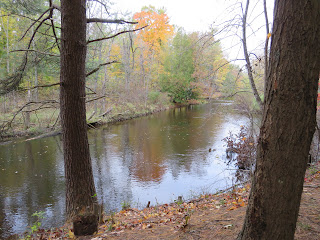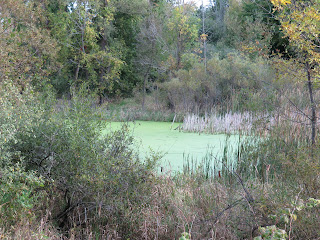Yesterday, I stayed close to home and hiked in Alma’s 50-acre
Conservation Park. The early morning weather was cloudy with a temperature of 37 degrees and a light gusty breeze from the west. From the parking lot, I headed west along the edge of the
Pine River millpond where I spotted a few
Canada Geese and Mute Swans swimming near the far shore. Continuing west, I noticed a patch of leafless Red-Osier
Dogwood with their burgundy branches. Just ahead, I paused on an observation deck to scan the
millpond where, at my feet, the leaf
litter showed mostly Aspen, Oak and Pine. Continuing west along a high bank above the river, I noticed the
leaf litter was dominated by Red and White Oak along with a few Beech. Turning south, I followed the dirt road past a mature leafless deciduous
forest to the newly renovated Girl Scout
Cabin. Just past the cabin, I saw a colorful patch of British Soldier
Lichens growing on a decomposing stump. Turning east, I first found evidence of deer activity including a fresh
buck rub and some
tracks in the mud before glancing ahead to see a
gathering of them staring at me. Little did they know how fortunate they are to live in this preserve that doesn’t allow hunting. Continuing east across the mowed grassland under the power lines, I entered a dense
wooded area of spruce and pine where I came face to face with a young curious
whitetail. Following the meandering trail as it turned north, I came upon a few red berries of
Viburnum and
Barberry. Exiting the woods, I followed a paved road back to the west where the leaf litter included rarely seen
Chinquapin Oak leaves. Next, I stopped at the Eyer Bird
Observation Hut where I watched the feeders for a few minutes and spotted a
Nuthatch, a Chickadee and a Downy
Woodpecker. Finally, I returned to the
car for a short drive home.
Far away from the hunter’s gun
Run, river run
By light of the moon, light of the sun
Run, river run
Your journey’s not over, only half done
Run, river run
Ice flows have not yet begun
Run, river run
Keeping you healthy is priority one
Pine River run
D. DeGraaf


















